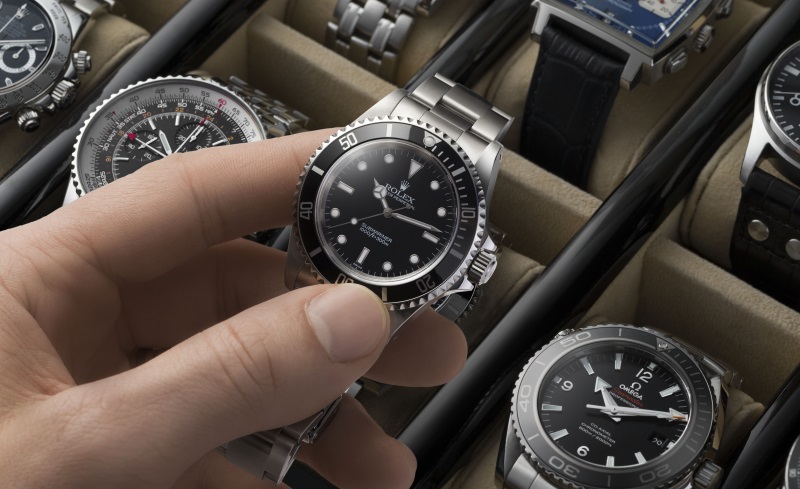If you want a chronograph from Rolex’s
stable, you can part ways with about $13,200 and get yourself the latest and
greatest ceramic 116500LN—or you could pay a quarter of a million for one of
these instead: the ‘Paul Newman’ 6263. How can it be worth 25 times more?
For outdated technology, the 116500LN is
actually pretty high-tech. You’ve got scratch-resistant ceramic, lab-grown
sapphire, antimagnetic alloys—and it all comes together at a facility furnished
with fingerprint scanners, glossy architecture and a parts department that only
robots are allowed in.
As far as new-old technology goes, the
Rolex Daytona as it stands today is somewhere towards the pinnacle, offering a
distilled blend of old-timey nostalgia and modern precision in a neat, 40mm
package. There’s a reason it’s so desirable—it just has everything.
But if it has everything, then what can an
old, kooky vintage version offer that it can’t? And more to the point, why did
one of these vintage Daytonas recently sell for the better part of $20 million?
It’s small, almost tiny at 37mm; has a weird dial that looks completely out of
place; is fitted with a rattly old bracelet—and yet watches like this routinely
sell for the price of a three-bed semi on the southeast coast.
It’s not like the 6263 was particularly
ground-breaking when it was new. By comparison, Omega’s 1957 Speedmaster was
selling like hotcakes, a revolutionary sports watch from a multi-award–winning
watchmaker that made Rolex’s efforts seem rather dated.
And that’s true more so than you might
think. You see, the Speedmaster arrived at a time when chronograph watches were
small and reserved, Rolex’s pre-Cosmograph 6234 included. The Speedmaster was
bigger, pushed the tachymeter to the bezel for more dial space, used a
high-contrast design for ultimate legibility—it pretty much defined the sports
chronograph.
And not only that, but the Speedmaster was
also mooted for the coveted role of NASA’s moon watch, having seen space
exploration already on Mercury astronaut Walter Schirra’s wrist. With Rolex
trying to pitch itself as the professional’s watchmaker, catering for divers,
scientists, explorers, and the like, the moon would be the perfect cherry on the
cake. But it was a young brand, and Omega was big, well-established. Enter the
Cosmograph.
Rolex was going to have its work cut out
trying to catch up with Omega, and it was with the 6239—an earlier version of
this 6263—that it tried. It was essentially a copy of the Speedmaster,
following the same design trends set down some six years before by Omega—albeit
much more simply and with less flourish.
Hedging its bets, Rolex also followed in
the footsteps of some other well-known watchmakers of the time, like Vulcain,
Bucherer and Lipp, offering an alternative ‘exotic’ dial like this one here
alongside the simpler standard item.
And while this 6263 has the word ‘Daytona’
on it, the originals did not. You can see how the placement of ‘Daytona’ above
the six o’clock sub-dial is a bit of an afterthought—and that’s because it is.
Rolex was going to the moon, remember—or so it believed—and the new breed of
Rolex professional watches were all named after their respective professions,
so this one was called ‘Cosmograph’—the space chronograph.
That, as we know, didn’t work out, and
Rolex was left scrambling not only for a new name but also for sales. After a
brief interlude as the ‘Le Mans’, the Cosmograph was hastily re-christened as
‘Daytona’, realigning it with another profession Rolex had a vested interest
in: motorsport.
But this couldn’t do anything for the
watch’s dismal sales. And if the standard Daytona did badly, the exotic dial
absolutely tanked. It’s rumored barely 2,000 were made, and even less
sold—demand was so low that jewelers were forced to practically give them
away.
It was the sale of one particular
exotic-dialed Daytona that eventually turned the fortunes of Rolex’s ailing
chronograph, to one Joanne Woodward, who purchased it as a gift for her
husband. He raced cars, which she hated, and so she had the following words
inscribed on the back before she gave it to him: ‘Drive carefully me’.
Her husband was, of course, Hollywood legend
Paul Newman and his appearance with the watch sowed the seed for its eventual
dominance of the vintage watch scene, and the association of his name with the
exotic dial. Limited numbers have driven prices up, and naturally, when that
original ‘Paul Newman’ came up for sale, its value skyrocketed.
From a logical standpoint, it’s bizarre
that the original Daytona could possibly hold more worth than a Speedmaster of
the same vintage, however, there’s something about Rolex’s struggle to compete
with well-established brands like Omega that really hits home. It’s the classic
underdog story, a tale of David and Goliath—and how the tables have turned
since. Omega may have got the moon, but Rolex¬—Rolex got the world.










_websize.jpg)









